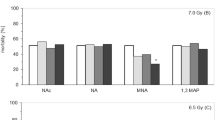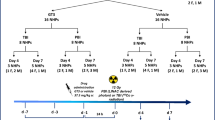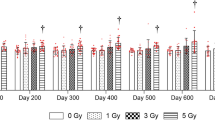Abstract
CONTRARY to previous reports1, Doherty et al. 2 obtained partial protection of X-irradiated mice with 2,3-dimercaptopropanol. If a foreign dithiol compound is effective perhaps the dithiol form of an essential metabolite might also prove beneficial in radiation injury. Mice were exposed to 550 r. acute whole body X-irradiation under our usual conditions3. The animals received 50 mgm./kgm. of DL-6,8-dithioloctanoic acid, the reduced form of thioctic acid, according to the schedule in Table 1. It is evident that the compound significantly increased the ST50 day, particularly if administered prior to irradiation. However, it has no real effect in reducing total mortality. The mechanisms involved in such partial protection are obscure, but dithiols are known to form resonance-stabilized radicals which could interact with the various oxidizing radicals produced by ionizing radiation. Such reactions could be continuous until the dithiol was completely destroyed. If the proportion of dithiol to oxidizeis was in favour of the latter, this could explain the increased ST50 day and the unaffected total mortality observed in the group receiving the dithiol immediately prior to irradiation. Pre-irradiation medication could also result in protection of radiosensitive groups in the tissues by direct combination, but it might be difficult to obtain complete coverage. Post-irradiation medication could assist in breaking the chain reaction involving organic peroxides5 but still not prevent the early damage which would tend to decrease total survival. Thus it would appear that a dithiol can increase survival time, possibly by the above mechanisms, yet give no permanent protection against the lethal effects of ionizing radiation.
This is a preview of subscription content, access via your institution
Access options
Subscribe to this journal
Receive 51 print issues and online access
$199.00 per year
only $3.90 per issue
Buy this article
- Purchase on Springer Link
- Instant access to full article PDF
Prices may be subject to local taxes which are calculated during checkout
Similar content being viewed by others
References
Bacq, Z. M., and Alexander, P., “Fundamentals of Radiobiology”, 290 (Butterworths Scientific Pub., London, 1955). Lagendorff, H., Koch, R., and Hagen, U., Strahlentherapie, 95, 238 (1954). Lagendorff, H., and Koch, R., ibid., 99, 567 (1956).
Doherty, D. G., Burnett, jun., W. T., and Shapira, R., Rad. Res., 7, 13 (1957).
Haley, T. J., Flesher, A. M., Veomett, R., and Vincent, R., Proc. Soc. Exp. Biol. Med., 96, 579 (1957).
Litchfield, jun., J. T., J. Pharmacol. Exp. Therap., 97, 399 (1949).
Mead, J. F., Science, 115, 470 (1952).
Author information
Authors and Affiliations
Rights and permissions
About this article
Cite this article
HALEY, T., FLESHER, A. & KOMESU, N. Effect of a Dithiol on Survival Time after Irradiation. Nature 181, 1405–1406 (1958). https://doi.org/10.1038/1811405b0
Issue Date:
DOI: https://doi.org/10.1038/1811405b0
Comments
By submitting a comment you agree to abide by our Terms and Community Guidelines. If you find something abusive or that does not comply with our terms or guidelines please flag it as inappropriate.



